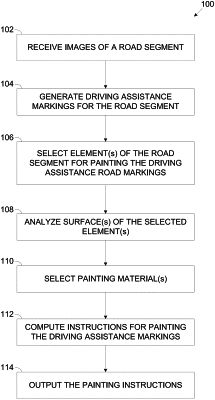| CPC G06V 20/588 (2022.01) [G05D 1/0242 (2013.01); G05D 1/0246 (2013.01); G06V 10/141 (2022.01); G06V 10/60 (2022.01); G05D 2201/0213 (2013.01)] | 15 Claims |

|
1. A method of detecting road marking in infrared spectral range, comprising:
using at least one processor for:
receiving at least one infrared image depicting, in at least one infrared spectral range, a portion of an edge of a road surface painted with road markings expressed using alternating high and low infrared reflective tiles and at least one visible light image depicting the portion of a road surface in visible light spectral range, the infrared reflective tiles are painted using at least one paint material characterized by: (1) reflecting light in visible light spectral range deviating less than a first value from the light reflected by the road surface, and (2) reflecting light in an infrared spectral range deviating more than a second value from the light reflected by the road surface;
registering the at least one infrared image to the at least one visible light image;
computing a ratio between an infrared reflectiveness value of each of a plurality of pixels of the at least one infrared image and a luminance value computed for a corresponding pixel in the registered at least one visible light image; and
detecting at least one high reflectiveness tile and at least one low reflectiveness tile based on a difference between the ratio of adjacent pixels exceeding a third value.
|